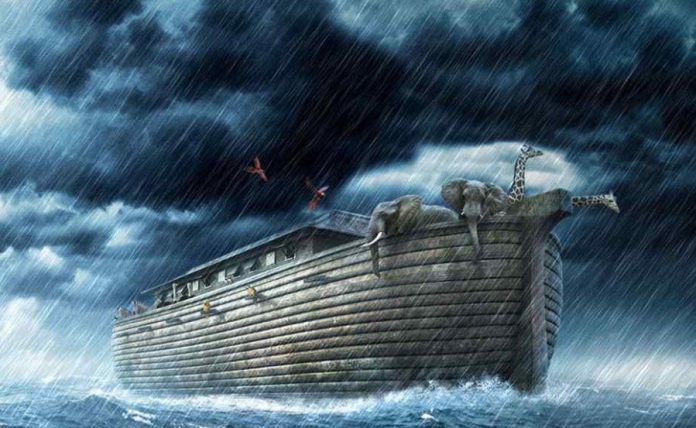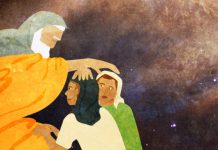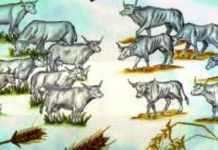The Great Flood, and the Tower of Babel
The sight was simply mind-boggling! Every species of land animal was lined up 2-by-2 in front of that gigantic edifice Noah had constructed with his own two hands. The column extended for miles. Anyone standing nearby could make out the giraffes, tigers, duck billed platypuses, rabbits, and mice – animals of every shape and size patiently waiting their turn to enter the Ark that would save their lives. The people of the evil generation, who refused to internalize Noah’s message to mankind, watched in a stupor as the procession proceeded.
“Could it really be true?” they asked each other. “That eccentric has spent 120 years building a giant boat all by himself, miles away from the nearest body of water!” Whenever those curious throngs questioned its purpose, Noah would reply, “You had better repent fast before the flood arrives. (How long can you tread water??) God is determined to destroy all living souls by a worldwide flood and your only hope is to change your lifestyle. This immorality must stop right away!”
The leaders of the generation were livid! “You just wait until the day you intend to enter your Ark. We’ll cut down the Ark and everyone aboard it!”
The fateful day arrived. As soon as the last of the animals had entered Noah’s refuge, the designated warriors were prepared to carry out their threat. The catapult’s missiles were readied for launching; the fiery arrows were already lit. Suddenly, a hundred animals emitted a great roar all at once. The lions and tigers and bears (Oh my!) all attacked in unison. The would-be warriors fled to the hills for fear of their lives. At that moment, it started to rain… (adapted from the Midrash)
Parshat Noah relates one of the oldest, and most widely told universal stories. Almost every ancient nation – from the American Indians to the Chinese – have a tradition of a flood connected to a tower. The Torah stresses the moral lesson: Man is responsible for the world, and his actions can destroy or preserve it!
THE GENERATIONS OF NOAH
“These are the generations of Noah” (Genesis 6:9). Instead of immediately informing us of Noah’s children, as is the normal procedure when mentioning generations, the verse continues, “Noah was a righteous man.” This compels the Sages to comment: “The main offspring of a person is his good deeds.”
When asked, “What are you living for?” people will often reply “for my children!” When the children grow up, they will also live for their children, and so on forever. I would love to meet the last generation that everyone was living for! Actually, people should live for themselves. First clarify what is really important in life, and then pass it down to your children. That is the greatest legacy you can leave them.
“The three sons of Noah were Shem, Cham, and Yefet” (Genesis 6:10). The commentaries explain that the sons’ names contain key insights into their character traits. Shem means “name” – he had the corresponding wisdom to give names that Adam possessed. Cham means “hot” – he embodied the sensuous heat of physical desires. Yefet means “beauty” – his legacy was the physical trappings of art and culture.
Allegorically, we can see in their names the proper way to perform Mitzvot and good deeds. We should do Mitzvot with “Shem,” for God’s name – meaning for the sake of Heaven without ulterior motives. Secondly, with “Cham,” with warmth and feeling – not mechanically to simply fulfill the obligation. Thirdly, a Mitzvah should be performed with “Yefet,” with beauty – i.e. in the nicest way possible. (Ma’ayana Shel Torah)
___________________
THE FLOOD
Humanity continued to misuse their huge life span (back then people lived for hundreds of years), and misused the opportunities God provided them for spiritual growth. God “regretted” creating man. Of course, an All-knowing and Almighty God does not really regret anything He does.
The Torah consistently refers to the Creator in human terms to impress upon us that He is not an abstract concept, relegated only to the topic of a weekly sermon. Rather, God is our spiritual father, Who relates to us and desires a mutual relationship with us.
God is one who we are able to and supposed to relate to. Therefore the Torah talks about God in human terms to bring out this point, assuming that we will understand not to take the terms literally. In this case, God is described as having anger and regret. (Rabbi S.R.Hirsch)
___________________
CONSTRUCTION OF THE ARK
The building of the Ark took many years of substantial toil by Noah himself. We can picture how the throngs came, during the many years which elapsed in the erection of the Ark, to gaze at this strange edifice and inquire its purpose. This was the last attempt to rescue the generation. Noah utilized his Ark as a theme and warning. He raised his voice to all who came, and encouraged them to do teshuva before the day of retribution. His words bore little fruit. (“Behold a People,” pg. 20)
Noah’s great contribution to mankind was morality. No doubt the people compared Noah’s barren labor in building the Ark with the more useful accomplishments of society – culture and technology. “Why don’t you do something more constructive, Noah?”
There was once a time when people believed that a cultured person was a good person. Since the Holocaust, this is no longer taken for granted. The occurrence of doctors and PhD’s who tortured their victims to death while listening to classical music and living in the height of culture and academia, was common in Nazi Germany. (Rabbi Avigdor Miller)
___________________
SPACE IN THE ARK
Question: How did all those animals fit into the Ark?
Answer: For God space is no problem.
When Albert Einstein first arrived in America, the reporters asked him to explain his Law of Relativity in language “we can understand!” He replied, “Originally it was believed that if you would put the entire universe into a suitcase, you would be left with endless space and infinite time. I taught the world, that if all matter were in the suitcase, so would space and time, by being relative to matter!” (heard from Rabbi Shlomo Wolbe)
This means that limitations of time and space are not our inventions, but creations of the Almighty and, accordingly, do not apply to Him. The Talmud says that the Holy Ark in the Temple of Jerusalem was too big to fit into its allotted space, and was inserted miraculously.
The book “The Neck of the Giraffe” (pg. 110) makes a mathematical calculation of Noah’s Ark. We start with the precise measurements in the Bible: 300 x 50 x 30 cubits. According to most calculations this would form a rectangular ship of considerable stability displacing about 24,000 tons, a good size even by modern standards, comparable with a modern British light aircraft carrier, and nearly half the displacement tonnage of a giant U.S. aircraft carrier.
The next question is how many species had to be squashed on board. Of the 1.5 million species living on Earth today, only a relatively small proportion had to be given houseroom. The fish of course remained swimming about in the sea. Noah only took the species living upon the face of the earth: people, cattle, creeping things, and fowl. The Ark should therefore contain an aviary with 25,000 species of birds, and an animal colony containing 25,000 species of amphibians, 6,000 species of reptiles, and 15,000 pairs of mammals – giving average space of less then one cubic meter for a pair of vertebrates, plus food supply for one year.
Another calculation works it out differently. Only 17,500 species had to be accounted for. We still have a slight problem with that figure. If you have studied several years of biology and a couple of years of physiology, you may have noticed that to preserve life on the earth, a male and female are required, preferably of the same species. So we need 17,500 males and 17,500 matching females of the same species, a total of 35,000 animals, inside the Ark. The average size of these animals is about the size of a sheep. Elephants, giraffes, rhinoceroses and hippos are averaged out by mice and prairie dogs. The huge animals of antiquity were not taken into the Ark and did not survive the flood.
We must also account for the insects. There are 850,000 species of insects. We need a male and female of each, totaling 1.7 million. Fortunately Noah didn’t have to figure out if he had a male and female tsetse fly, because God brought all the animals to him. Noah may have given each of these insects 2 inches of flying space, being very careful to pack the termites in the middle.
The Ark, equivalent to a zoo 26 miles long (Behold a People p. 19) had the capacity to hold all the animals in the middle story, Noah and his family on the top story, and plenty of room on the bottom story for waste disposal.
___________________
BECAUSE OF THE FLOOD WATERS
The Torah stresses that Noah and his family entered the Ark only because of the waters of the flood (Genesis 7:7). The Sages perceive here a slight reprimand: Why did Noah only enter when he felt the raindrops? Isn’t the word of God sufficient? “Noah was a small believer” proclaim the Sages. This is in contrast to Abraham, as we will see in next week’s Parsha.
Question: What is an example of a “big believer?”
Answer: The Talmud tells of Rabbi Yochanan ben Zakai, who wanted to make peace with the Romans. He called to General Vespasian, “Oh Emperor, have mercy!”
The General replied, “The emperor is in Rome!”
The rabbi replied, “You must be the emperor – because God is letting you capture the Holy City, and the rabbis learn from verses that this would only be accomplished by a king. So don’t argue with me – you are the emperor and king!”
At that moment, a messenger arrived huffing and puffing. “The Emperor is dead and the Senate has appointed you to be his successor!”
Now that is a real big believer! Rabbi Yochanan ben Zakai was ready to take on the top general. Noah, on the other hand, after toiling on the Ark for 120 years and having warned the world of an impending flood, actually waits until he sees the raindrops before entering the Ark!
___________________
IT’S RAINING, IT’S POURING!
The Great Flood came in the Jewish year 1656 since creation. For 40 days the rain fell and covered all the mountains where the people took refuge (Genesis 7:19). The Sages explain the significance of 40 days, as corresponding to the formation of a fetus in the womb. Because the people had acted with sexual immorality, they were now being punished accordingly.
In the Ark, Noah toiled by day and by night, caring for the living things under his management. Although many animals went into hibernation, this huge menagerie still taxed the efforts of Noah and the 7 members of his family. During these months of superhuman toil, Noah learned an important lesson: “Man is responsible for the preservation of the world!” His misdeeds can cause universal disaster, and his virtue can uphold its existence.
The Flood left many marks upon the world. The North American continent – from Alaska to Mexico – shows plainly that an ocean once covered it. The Himalayas and other mountain ranges are covered with innumerable deep-sea fossils. Water levels are discernable at the top of the great land-basins which today lie far above sea level.
The inscriptions of ancient peoples everywhere relate the story of the Flood in connection with a tower. The ancient chronicler Berosus the Chaldean (a contemporary of Alexander the Great) copied the old stone inscriptions concerning the Flood, intermingled with the confusion and fantasies of ancient mythological fairy tales. The Gilgamesh Epic has been unearthed, and it too describes the Flood. But nowhere is this event so clearly described, and in such detail as in the Torah, and nowhere is the moral lesson brought so clearly to the fore. (“Behold a People,” pg. 21)
___________________
THE RAVEN AND THE DOVE
Noah sent out a raven first, to test the dryness of the Earth. The commentaries explain that Noah reasoned that an undomesticated bird, such as a raven, would prefer its freedom even if the land were still muddy, if it was in any way habitable.
The raven circled the Ark and did not find any dry land. The Sages explain that he refused to go on his mission, claiming that if anything happens to him the race would be extinct. “I’m the only raven around!” he proclaimed.
Noah then sent the dove, (the kosher animals numbered 7 males and 7 females each). The dove, a domesticated bird, would only stay away if he found a fully dry patch of land. On its third mission, the dove did not return.
___________________
THE RAINBOW
God makes a covenant with Noah that He will not destroy the entire world again with a Flood. The symbol of this covenant is the rainbow. The rainbow is divided into so many colors and hues, yet when they are combined they all become one bright white. So too, mankind appears divided, yet we are all one!
When observing a rainbow, we recite a blessing: “Blessed is God, Who remembers the covenant (of Noah).”
However, the rabbis discourage one from staring at a rainbow, since it has a negative message: The world really deserves a flood, but because of God’s covenant we’ll let you slide!
The Talmud relates that during the lifetimes of certain great sages, a rainbow was never seen, because they were capable of saving the world from a flood, in their own merit!
___________________
THE TOWER OF BABEL
The descendants of Noah all decided to live together in the great valley of Babel. They appointed the first dictator and all spoke the same language (Hebrew, according to tradition). They then decided to wage war on their Creator. “We will build a Tower to ascend Heaven and battle the Almighty!”
Others explain that they denied God’s Hand in the Flood, and saw it simply as a quirk of nature. Thus it was imperative to build supports for the Heavens, to insure that they don’t fall down again!
In any case, from an ideological standpoint they were much worse than the generation of the Flood. Yet they were not killed like the previous generation, because they had the great trait of unity amongst themselves!
This was the first dictatorship, where the individual is not important, only the society. The Sages comment that when a brick would fall down during construction of the Tower, people would bemoan the loss: “How long will it take to carry another one up!” However if a person fell, he was considered expendable. Such a monolithic society could never produce an independent thinker such as our forefather Abraham.
God once again took counsel from the angels (see Parshat Bereishit) and came down to see for Himself (i.e. get as much first-hand evidence as possible!). God confused them into now speaking 70 different languages (Babel = babble), corresponding to the list of Noah’s descendents in the end of the Parsha. They could not communicate with each other, let alone coordinate such an enormous project.
According to the Midrash, one-third of the Tower collapsed, one-third sunk into the ground, and one-third was a reminder of the great folly of mankind’s undertaking. The 70 languages were scattered around the globe, giving rise to diverse cultures. Only the descendents of Shem (the Semites) retained the original language, Hebrew.
Next week: the beginnings of Jewish history.
credit to aish.com
Shabbat Shalom !












